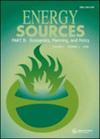Do new energy power generation companies have better financial performance? An analysis for China’s power generation industry
IF 2.2
4区 工程技术
Q3 ENERGY & FUELS
Energy Sources Part B-Economics Planning and Policy
Pub Date : 2022-01-05
DOI:10.1080/15567249.2021.2023707
引用次数: 1
Abstract
ABSTRACT Fossil-fired power generation is the most significant contributor to China’s carbon emissions. New energy such as wind and solar is rapidly deploying in China and is considered an alternative to fossil energy. This paper focuses on the comparison in financial performance between fossil-fired generation and new energy generation companies. To do so, we combine the listed companies’ financial data from 2010 to 2020 with the catastrophe progression method to evaluate the financial performance of China’s power generation companies. The results indicate that although the profitability of the fossil-fired generation industry has stagnated in the past ten years, its comprehensive financial performance is still better than that of the new energy industry. The profitability of new energy companies has increased significantly in the past decade, especially the wind energy companies, whose profitability has greatly improved from 2013 to 2020. Wind power generation also has outstanding operating capacity among new energy generations.新能源发电企业财务业绩更好吗?中国发电行业分析
摘要:化石燃料发电是中国碳排放的最大来源。风能和太阳能等新能源正在中国迅速发展,被认为是化石能源的替代品。本文主要对化石燃料发电企业和新能源发电企业的财务绩效进行比较。为此,我们结合2010年至2020年上市公司的财务数据,运用巨灾级数法对中国发电企业的财务绩效进行了评价。结果表明,尽管近十年来火电发电行业的盈利能力停滞不前,但其综合财务绩效仍优于新能源行业。近十年来,新能源企业的盈利能力显著提升,尤其是风能企业,2013年至2020年盈利能力大幅提升。风力发电在新一代能源中也具有突出的运行能力。
本文章由计算机程序翻译,如有差异,请以英文原文为准。
求助全文
约1分钟内获得全文
求助全文
来源期刊

Energy Sources Part B-Economics Planning and Policy
ENERGY & FUELS-
CiteScore
6.80
自引率
12.80%
发文量
42
审稿时长
6-12 weeks
期刊介绍:
12 issues per year
Abstracted and/or indexed in: Applied Science & Technology Index; API Abstracts/Literature; Automatic Subject Index Citation; BIOSIS Previews; Cabell’s Directory of Publishing Opportunities in Economics and Finance; Chemical Abstracts; CSA Aquatic Science & Fisheries Abstracts; CSA Environmental Sciences & Pollution Management Database; CSA Pollution Abstracts; Current Contents/Engineering, Technology & Applied Sciences; Directory of Industry Data Sources; Economic Abstracts; Electrical and Electronics Abstracts; Energy Information Abstracts; Energy Research Abstracts; Engineering Index Monthly; Environmental Abstracts; Environmental Periodicals Bibliography (EPB); International Abstracts in Operations Research; Operations/Research/Management Science Abstracts; Petroleum Abstracts; Physikalische Berichte; and Science Citation Index.
Taylor & Francis make every effort to ensure the accuracy of all the information (the "Content") contained in our publications. However, Taylor & Francis, our agents, and our licensors make no representations or warranties whatsoever as to the accuracy, completeness, or suitability for any purpose of the Content. Any opinions and views expressed in this publication are the opinions and views of the authors, and are not the views of or endorsed by Taylor & Francis. The accuracy of the Content should not be relied upon and should be independently verified with primary sources of information. Taylor & Francis shall not be liable for any losses, actions, claims, proceedings, demands, costs, expenses, damages, and other liabilities whatsoever or howsoever caused arising directly or indirectly in connection with, in relation to, or arising out of the use of the Content. Terms & Conditions of access and use can be found at http://www.tandfonline.com/page/terms-and-conditions .
 求助内容:
求助内容: 应助结果提醒方式:
应助结果提醒方式:


